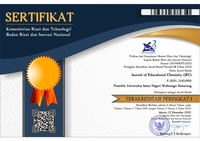Chem is Fun: Animation Learning Media Based on Quantum Learning on Atomic Structure
DOI:
https://doi.org/10.21580/jec.2021.3.1.6583Keywords:
chem is fun, interactive animation, learning media, quantum learningAbstract
Good learning media are media that can facilitate students to understand the material. The selection of learning media must be in accordance with the characteristics of the teaching material. To facilitate explaining the atomic structure material that is abstract, we need a medium that can realize the material. This study aimed to develop an interactive animation learning media Chem is Fun based on quantum learning and determine the quality of the product. The development model used was the ADDIE model by adapting the development procedures, namely the analysis, design, development, and evaluation stages. This study involved one media expert, one material expert, three peer reviewers, and five reviewers to assess product quality. The instrument used in this study consisted of an advice sheet and a questionnaire. The results of the study state that the learning media product Chem is Fun based on quantum learning has good quality, so it can be used as a learning medium to help students' learning process on atomic structure material.Downloads
References
A’la, M. (2012). Quantum Teaching. Yogyakarta: Diva Press.
Cairncross, S. & Mannion, M. (2010). Interactive Multimedia and Learning: Realizing the Benefits. Innovations in Education and Teaching International, 38 (2), 156-164.
DePorter, B., & Hernacki, M. (1992). Quantum Learning: Unleashing the Genius in You. New York: Dell Publishing.
Fibonacci, A. & Sudarmin. (2014). Development Fun-Chem Learning Materials Integrated Socio-Science Issues to Increase Students Scientific Literacy. International Journal of Science and Research, 3(11), 708-713.
Heinich, R., Molenda, M., Russel, J.D., & Smaldino, S.E. (2005). Instructional Technology and Media for Learning Seventh Edition. New Jersey: Pearson Merrill Prentice Hall.
Kustandi, C. & Sutjipto, B. (2011). Media Pembelajaran Manual dan Digital. Bogor: Ghalia Indonesia.
Lin, M.H., Chen, H.C., & Liu, K.S. (2017). A Study of The Effects of Digital Learning on Learning Motivation and Learning Outcome. EURASIA Journal of Mathematics Science and Technology Education, 13 (7), 3553-3564.
Prastowo, A. (2012). Panduan Kreatif Membuat Bahan Ajar Inovatif. Yogyakarta: Diva Press.
Sugihartono, Fathiyah, K.N., Setyawati, F.A., Harahap, F., & Nurhayati, S.R. (2007). Psikologi Pendidikan. Yogyakarta: UNY Press.
Tsaparlis, G. & Papaphotis, G. (2009). High-School Students' Conceptual Difficulties and Attempts at Conceptual Change: The Case of Basic Quantum Chemical Concepts. International Journal of Science Education, 31 (7), 895-930.
Yanuschika, O.V., Pakhomovaa, E.G., & Batbold, K. (2015). E-learning as a Way to Improve the Quality of Educational for International Students. Procedia-Social and Behavioral Sciences, 215 (8), 147-155
Yavuz, R. & Acikalin, F.S. (2018). How the Seventh Grade Students Visualize Atomic Structure and Models. SHS Web of Conferences, 48.
Downloads
Published
How to Cite
Issue
Section
License
The copyright of the received article shall be assigned to the journal as the publisher of the journal. The intended copyright includes the right to publish the article in various forms (including reprints). The journal maintains the publishing rights to the published articles.
Authors are permitted to disseminate published articles by sharing the link/DOI of the article at the journal. Authors are allowed to use their articles for any legal purposes deemed necessary without written permission from the journal with an acknowledgment of initial publication to this journal.

This work is licensed under a Creative Commons Attribution-NonCommercial-ShareAlike 4.0 International License.



